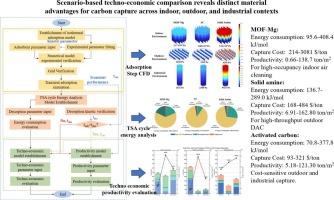碳捕获吸附剂的材料-情景耦合技术-经济比较:在各种情况下的可行性和适用性
IF 10.9
1区 工程技术
Q1 ENERGY & FUELS
引用次数: 0
摘要
日益紧迫的气候变化凸显了对成本低、节能的碳捕获技术的需求,这种技术可以在不同的环境中部署。然而,在不同应用场景下对代表性吸附剂的比较评估仍然有限,在理解材料的适用性方面留下了空白,超出了孤立的性能指标。本研究建立了固定床吸附的三维瞬态数值模型,对金属有机骨架(MOF-Mg-74)、活性炭和固体胺三种代表性吸附剂进行了评价。简化的能源和技术经济框架进一步应用于量化中国室内空气净化、室外直接空气捕获(DAC)和工业烟气条件下的生产率、能源需求和捕集成本。评估周期为1年(短期)、3年(中期)和10年(长期)。结果显示了明显的场景依赖优势。性能包膜如下:金属有机骨架能耗为95.6 ~ 408.4 kJ/mol,捕集成本为214 ~ 3081美元/吨,生产率为0.66 ~ 138.7吨/m2;固体胺表现为136.7 ~ 289.0 kJ/mol、168 ~ 484 $/ton和6.91 ~ 162.80 ton/m2;活性炭达到70.8 ~ 377.8 kJ/mol, 93 ~ 321美元/吨,5.18 ~ 121.30吨/m2。研究还表明,金属-有机框架最适合于高占用率的室内空气净化,固体胺最适合于高通量的室外直接空气捕获,活性炭最适合于成本敏感的室外和工业捕获。为了加速商业化,建议降低金属有机骨架的合成成本,提高活性炭的吸附能力,提高固体胺的循环稳定性和解吸热,并整合低品位或可再生热能,以进一步降低运营成本,增强可持续性。本文章由计算机程序翻译,如有差异,请以英文原文为准。

Material–scenario coupled techno-economics comparison of carbon capture adsorbents: Feasibility and suitability across various contexts
The rising urgency of climate change highlights the need for cost- and energy-efficient carbon capture technologies that can be deployed across diverse environments. However, comparative evaluations of representative adsorbents under different application scenarios remain limited, leaving a gap in understanding the suitability of materials beyond isolated performance metrics. In this study, a three-dimensional transient numerical model of fixed-bed adsorption was developed to evaluate three representative sorbents—metal–organic framework (MOF-Mg-74), activated carbon, and a solid amine. A simplified energy and techno-economic framework was further applied to quantify productivity, energy demand, and capture cost of operation in China across indoor air purification, outdoor direct air capture (DAC), and industrial flue-gas conditions. The durations of the evaluation cycle are 1 year (short-term), 3 years(mid-term) and 10 years (long-term). Results reveal clear scenario-dependent advantages. The performance envelopes are as follows: metal–organic framework shows energy consumption of 95.6–408.4 kJ/mol, capture costs of 214–3081 $/ton, and productivity of 0.66–138.7 ton/m2; solid amine exhibits 136.7–289.0 kJ/mol, 168–484 $/ton, and 6.91–162.80 ton/m2; activated carbon achieves 70.8–377.8 kJ/mol, 93–321 $/ton, and 5.18–121.30 ton/m2. It also indicates that metal–organic framework is most suitable for high-occupancy indoor air cleaning, solid amine for high-throughput outdoor direct air capture, and activated carbon for cost-sensitive outdoor and industrial capture. To accelerate commercialization, it is recommended that reducing metal–organic framework’s synthesis cost, enhancing activated carbon’s adsorption capacity, improving solid amine’s cyclic stability and desorption heat, and integrating low-grade or renewable thermal energy to further curtail operating expenses and bolster sustainability.
求助全文
通过发布文献求助,成功后即可免费获取论文全文。
去求助
来源期刊

Energy Conversion and Management
工程技术-力学
CiteScore
19.00
自引率
11.50%
发文量
1304
审稿时长
17 days
期刊介绍:
The journal Energy Conversion and Management provides a forum for publishing original contributions and comprehensive technical review articles of interdisciplinary and original research on all important energy topics.
The topics considered include energy generation, utilization, conversion, storage, transmission, conservation, management and sustainability. These topics typically involve various types of energy such as mechanical, thermal, nuclear, chemical, electromagnetic, magnetic and electric. These energy types cover all known energy resources, including renewable resources (e.g., solar, bio, hydro, wind, geothermal and ocean energy), fossil fuels and nuclear resources.
 求助内容:
求助内容: 应助结果提醒方式:
应助结果提醒方式:


